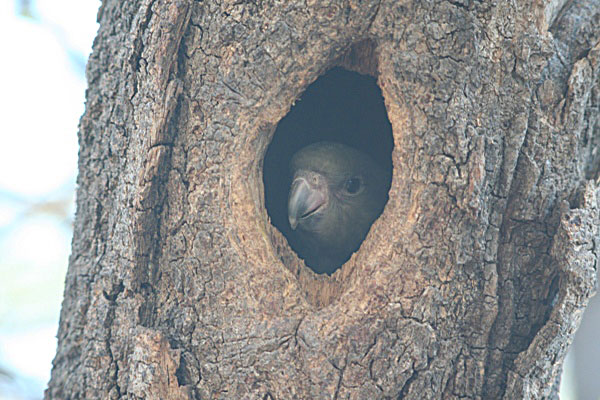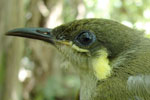
Brown-headed parrot (Poicephalus cryptoxanthus) fledgling in tree cavity in Botswana. Photo by: Tiffany Roufs.
Aged, living trees are essential for over 1,000 birds and mammals that depend on such trees for nesting holes, according to a study in Frontiers in Ecology and the Environment. In much of the world, tree-nesting animals depend on holes formed through maturity and decay—and not woodpeckers—requiring standing old trees.
“Most trees have to be more than 100 years old before decay cavities begin to form and often several centuries old before large cavities or many cavities develop in one tree,” explains Kathy Martin, a professor in the Faculty of Forestry at the University of British Columbia, in a press release. Yet these are the trees that logging companies target first.
“Forest policies help protect younger trees but promote the harvest of older, larger, living trees—the very trees needed by cavity-nesting animals,” Martin adds.
Animals that depend on nesting holes include songbirds, owls, parrots, flying squirrels, possums, as well as some snakes, amphibians, and insects.
According to the study, 75 percent of animals that nest in trees on four continents (South America, Asia, Australia, and Europe) depend on holes formed through long-term decay. North American is the outlier: there animals depend almost entirely on woodpeckers to create their nesting homes. While woodpeckers are present in other parts of the world, the study found that holes created by woodpeckers outside North America did not last as long as those created through decay.
“The value of these large living trees needs to be recognized and we need to ensure that a supply of these trees is retained especially in tropical forest systems where decay-formed tree holes last for many years and support a lot of wildlife,” Martin concludes.
CITATION: Kristina L Cockle, Kathy Martin, Tomasz Wesołowski. Woodpeckers, decay, and the future of cavity-nesting vertebrate communities worldwide. Frontiers in Ecology and the Environment, 2011; : 110531072704016 DOI: 10.1890/110013.
Related articles
Primary forest best for birds in Papua New Guinea

(09/26/2011) A new survey recorded 125 birds in Papua New Guinea’s Waria Valley, of which an astounding 43 percent were endemic to the island. The survey, published in mongabay.com’s open-access journal Tropical Conservation Science, was the first of its kind for the rainforest-studded valley and found that bird populations were most diverse and abundant in primary forests. The bird surveys were carried out in four different habitats including primary forest, primary forest edges, secondary forest edges, and agricultural landscape.
Old-growth forests are irreplaceable for sustaining biodiversity

(09/14/2011) Old growth rainforests should be a top conservation priority when it comes to protecting wildlife, reports a new comprehensive assessment published in the journal Nature. The research examined 138 scientific studies across 28 tropical countries. It found consistently that biodiversity level were substantially lower in disturbed forests.